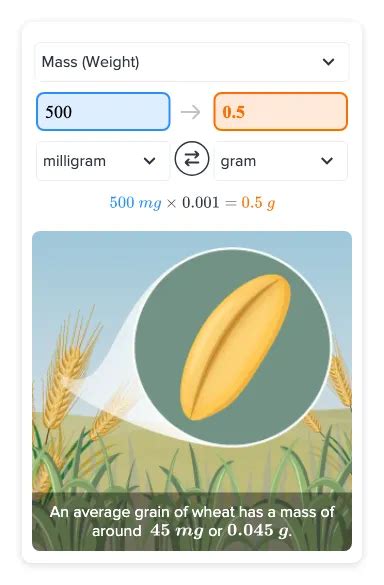500 Mg Is Equal To How Many Grams
Kalali
Apr 01, 2025 · 4 min read

Table of Contents
500 mg is Equal to How Many Grams? A Comprehensive Guide to Metric Conversions
Understanding metric conversions is crucial in various fields, from cooking and medicine to science and engineering. One common conversion many people encounter is converting milligrams (mg) to grams (g). This comprehensive guide will not only answer the question "500 mg is equal to how many grams?" but also delve into the underlying principles of metric conversions, providing you with the knowledge to perform similar calculations confidently.
Understanding the Metric System:
The metric system, also known as the International System of Units (SI), is a decimal system based on powers of 10. This means that units are related by factors of 10, making conversions relatively straightforward. The key to understanding metric conversions lies in knowing the prefixes that indicate the magnitude of the unit.
Key Prefixes in the Metric System:
- Kilo (k): 1000 times the base unit (e.g., 1 kilogram = 1000 grams)
- Hecto (h): 100 times the base unit
- Deca (da): 10 times the base unit
- Deci (d): 1/10 of the base unit
- Centi (c): 1/100 of the base unit
- Milli (m): 1/1000 of the base unit
- Micro (µ): 1/1,000,000 of the base unit
Converting Milligrams to Grams:
The relationship between milligrams (mg) and grams (g) is based on the "milli" prefix. "Milli" signifies 1/1000, meaning 1 gram is equal to 1000 milligrams. Therefore, the conversion factor is:
1 g = 1000 mg
To convert milligrams to grams, you simply divide the number of milligrams by 1000.
So, 500 mg is equal to 500 mg / 1000 mg/g = 0.5 g
Therefore, 500 milligrams is equal to 0.5 grams.
Practical Applications of mg to g Conversion:
Understanding this conversion is vital in numerous situations:
-
Medicine: Many medications are prescribed in milligrams, but dosages are often compared or calculated in grams. Accurate conversion is crucial for safe and effective medication administration. For instance, understanding that a 500mg tablet is 0.5g allows for easier comparison of different dosages.
-
Science and Research: In scientific experiments, accurate measurements are paramount. Converting between milligrams and grams ensures consistency and precision in recording and analyzing data. This is especially important in fields like chemistry, where precise measurements are crucial for reactions and experiments.
-
Cooking and Baking: While less common than in scientific contexts, precise measurements can be important in some baking and cooking situations, especially when dealing with smaller quantities of ingredients like spices or flavorings. Converting milligrams to grams allows for the accurate scaling of recipes.
-
Engineering and Manufacturing: Precision engineering relies heavily on accurate measurements. Converting between milligrams and grams is vital in applications requiring high levels of accuracy and precision in manufacturing components and parts.
Beyond 500 mg: Mastering Milligram to Gram Conversions
Now that we've established the conversion for 500 mg, let's expand our knowledge to handle various milligram values. The fundamental principle remains the same: divide the number of milligrams by 1000 to get the equivalent in grams.
Examples:
- 1000 mg = 1 g (This is the base conversion)
- 250 mg = 0.25 g (250 / 1000 = 0.25)
- 750 mg = 0.75 g (750 / 1000 = 0.75)
- 1250 mg = 1.25 g (1250 / 1000 = 1.25)
- 10 mg = 0.01 g (10 / 1000 = 0.01)
Using Calculators and Online Converters:
While manual calculation is straightforward, numerous online converters and calculators are available to simplify the process. These tools are particularly helpful when dealing with multiple conversions or more complex calculations involving other metric units. However, understanding the underlying principles is still valuable for verifying results and enhancing your understanding of the metric system.
Common Mistakes to Avoid:
-
Forgetting the decimal point: A common error is neglecting to account for the decimal point when dividing by 1000. Always double-check your calculations to ensure accuracy.
-
Confusing milligrams and grams: Ensure you are correctly identifying whether a given value is in milligrams or grams before performing the conversion. Pay close attention to the unit symbols (mg and g).
-
Using the wrong conversion factor: The conversion factor is always 1000 mg/g. Using a different factor will lead to an incorrect result.
Expanding Your Metric Conversion Knowledge:
Mastering milligram to gram conversions is a stepping stone to understanding other metric conversions. Learning to confidently convert between different metric units will broaden your practical skills in various fields. Consider exploring conversions involving:
- Kilograms (kg) to grams (g): 1 kg = 1000 g
- Grams (g) to kilograms (kg): 1 g = 0.001 kg
- Liters (L) to milliliters (mL): 1 L = 1000 mL
- Meters (m) to centimeters (cm): 1 m = 100 cm
Conclusion:
Understanding metric conversions is a valuable skill applicable to a wide array of disciplines. Knowing that 500 mg equals 0.5 g is just the beginning. By understanding the underlying principles of the metric system and practicing conversions, you will build confidence and accuracy in your calculations, leading to better results in your work and studies. Remember the key: divide milligrams by 1000 to obtain the equivalent in grams. With practice, these conversions will become second nature.
Latest Posts
Latest Posts
-
How Many Cups In 5 Quarts Of Water
Apr 02, 2025
-
12 Out Of 18 As A Percentage
Apr 02, 2025
-
What Is A 36 Out Of 50
Apr 02, 2025
-
Describe The Cross Section Of The Rectangular Prism
Apr 02, 2025
-
7 Liters Is How Many Gallons
Apr 02, 2025
Related Post
Thank you for visiting our website which covers about 500 Mg Is Equal To How Many Grams . We hope the information provided has been useful to you. Feel free to contact us if you have any questions or need further assistance. See you next time and don't miss to bookmark.
